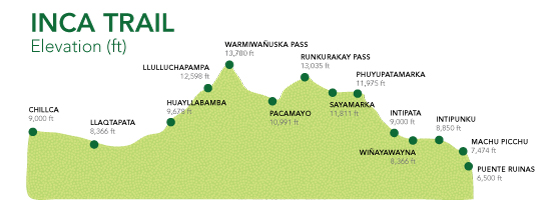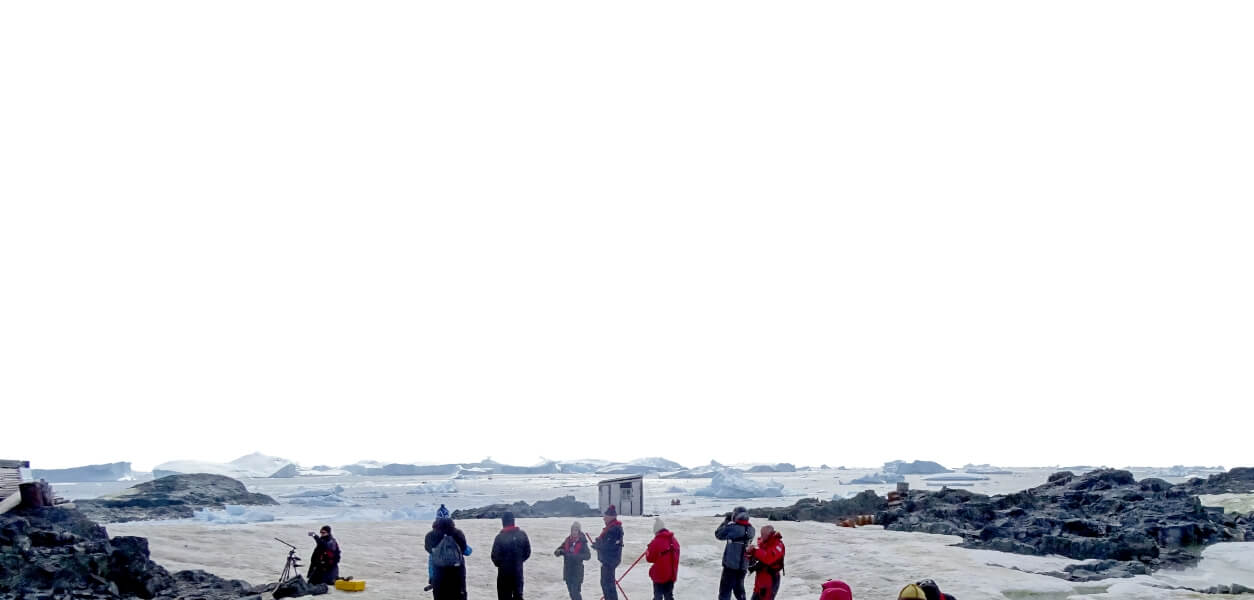Hiking the Inca Trail is an experience of a lifetime, and preparing is part of the adventure. Our Inca Trail hike with Road Scholar includes three days of pre-hikes to help acclimatize you to the altitude and terrain of the trail, and the following information will help you get ready before your departure.
TRAINING RECOMMENDATIONS
 Upon arrival at altitudes above 3,000 m or 10,000 ft, shortness of breath and a pounding heart are normal responses to the lack of oxygen in the air. However, for some visitors, these symptoms can deteriorate into a condition known as Soroche or acute mountain sickness. Headache, extreme tiredness, nausea and loss of appetite are standard symptoms. Take it easy upon arrival and drink the coca tea provided. Oxygen is readily available for more
severe reactions and is also available on the Inca Trail.
Staying hydrated and well rested is important to adjust to the altitude. Avoiding heavy, fatty foods and alcohol in the days before arriving to altitude can help. It’s also advisable to avoid sleep medications, as they can slow breathing and respiration, which aid in getting the blood oxygenated while sleeping.
Participants who take blood pressure medications should discuss this with their doctor as the medication can drop pressure too low at times.
AVERAGE DISTANCE, WALKING TIME, AND ALTITUDE PER DAY
Day 1: Chillca - Huayllabamba
Total distance: 7.8 miles
Estimated walking time: 7 hours
Maximum altitude point: 9,842 feet
Day 2: Huayllabamba - Pacamayo
Total distance: 5.5 miles
Estimated walking time: 7 hours
Maximum altitude point: 13,779 feet
Day 3: Pacamayo - Phuyupatamarka
Total distance: 5 miles
Estimated walking time: 7 hours
Maximum altitude point: 12,795 feet
Day 4: Phuyupatamarka - Machu Picchu
Total distance: 7 miles
Estimated walking time: 5 hours
Maximum altitude point: 11,811 feet
Upon arrival at altitudes above 3,000 m or 10,000 ft, shortness of breath and a pounding heart are normal responses to the lack of oxygen in the air. However, for some visitors, these symptoms can deteriorate into a condition known as Soroche or acute mountain sickness. Headache, extreme tiredness, nausea and loss of appetite are standard symptoms. Take it easy upon arrival and drink the coca tea provided. Oxygen is readily available for more
severe reactions and is also available on the Inca Trail.
Staying hydrated and well rested is important to adjust to the altitude. Avoiding heavy, fatty foods and alcohol in the days before arriving to altitude can help. It’s also advisable to avoid sleep medications, as they can slow breathing and respiration, which aid in getting the blood oxygenated while sleeping.
Participants who take blood pressure medications should discuss this with their doctor as the medication can drop pressure too low at times.
AVERAGE DISTANCE, WALKING TIME, AND ALTITUDE PER DAY
Day 1: Chillca - Huayllabamba
Total distance: 7.8 miles
Estimated walking time: 7 hours
Maximum altitude point: 9,842 feet
Day 2: Huayllabamba - Pacamayo
Total distance: 5.5 miles
Estimated walking time: 7 hours
Maximum altitude point: 13,779 feet
Day 3: Pacamayo - Phuyupatamarka
Total distance: 5 miles
Estimated walking time: 7 hours
Maximum altitude point: 12,795 feet
Day 4: Phuyupatamarka - Machu Picchu
Total distance: 7 miles
Estimated walking time: 5 hours
Maximum altitude point: 11,811 feet

- Incorporate some form of cardio exercise, 45 to 60 minutes, 2 to 3 times a week for at least 8 to 12 weeks prior to your trip. We suggest running, walking, or biking.
- Prepare for the extreme ups and downs of the hike by training across a variety of terrains such as hills or using a treadmill incline.
- Practice yoga or some form of core strengthening exercise.
- Small day pack to carry your sunglasses, hat, sunscreen, insect repellent, camera, water bottle or CamelBak, and rain gear
- Hiking boots
- A pair of comfortable shoes or crocs to wear around the camp
- One complete change of clothing per day including pants, t-shirts, socks, and underwear
- Fleece and down jacket
- Gloves and winter hat
- Warm fleece pants for evening
- Personal toiletries, including baby wipes, and medications
- Camera gear with enough charged batteries for the entire hike
- Flashlight and batteries
- There is no need to bring energy bars or snacks; plenty of food and snacks will be provided.
- Break in your boots well in advance of your departure.
- Wear your hiking boots on the flight or pack them in your carry-on bag in case luggage is lost or delayed.
- There won’t be an opportunity to recharge batteries other than at the hotel in Aguas Calientes.
 Upon arrival at altitudes above 3,000 m or 10,000 ft, shortness of breath and a pounding heart are normal responses to the lack of oxygen in the air. However, for some visitors, these symptoms can deteriorate into a condition known as Soroche or acute mountain sickness. Headache, extreme tiredness, nausea and loss of appetite are standard symptoms. Take it easy upon arrival and drink the coca tea provided. Oxygen is readily available for more
severe reactions and is also available on the Inca Trail.
Staying hydrated and well rested is important to adjust to the altitude. Avoiding heavy, fatty foods and alcohol in the days before arriving to altitude can help. It’s also advisable to avoid sleep medications, as they can slow breathing and respiration, which aid in getting the blood oxygenated while sleeping.
Participants who take blood pressure medications should discuss this with their doctor as the medication can drop pressure too low at times.
AVERAGE DISTANCE, WALKING TIME, AND ALTITUDE PER DAY
Day 1: Chillca - Huayllabamba
Total distance: 7.8 miles
Estimated walking time: 7 hours
Maximum altitude point: 9,842 feet
Day 2: Huayllabamba - Pacamayo
Total distance: 5.5 miles
Estimated walking time: 7 hours
Maximum altitude point: 13,779 feet
Day 3: Pacamayo - Phuyupatamarka
Total distance: 5 miles
Estimated walking time: 7 hours
Maximum altitude point: 12,795 feet
Day 4: Phuyupatamarka - Machu Picchu
Total distance: 7 miles
Estimated walking time: 5 hours
Maximum altitude point: 11,811 feet
Upon arrival at altitudes above 3,000 m or 10,000 ft, shortness of breath and a pounding heart are normal responses to the lack of oxygen in the air. However, for some visitors, these symptoms can deteriorate into a condition known as Soroche or acute mountain sickness. Headache, extreme tiredness, nausea and loss of appetite are standard symptoms. Take it easy upon arrival and drink the coca tea provided. Oxygen is readily available for more
severe reactions and is also available on the Inca Trail.
Staying hydrated and well rested is important to adjust to the altitude. Avoiding heavy, fatty foods and alcohol in the days before arriving to altitude can help. It’s also advisable to avoid sleep medications, as they can slow breathing and respiration, which aid in getting the blood oxygenated while sleeping.
Participants who take blood pressure medications should discuss this with their doctor as the medication can drop pressure too low at times.
AVERAGE DISTANCE, WALKING TIME, AND ALTITUDE PER DAY
Day 1: Chillca - Huayllabamba
Total distance: 7.8 miles
Estimated walking time: 7 hours
Maximum altitude point: 9,842 feet
Day 2: Huayllabamba - Pacamayo
Total distance: 5.5 miles
Estimated walking time: 7 hours
Maximum altitude point: 13,779 feet
Day 3: Pacamayo - Phuyupatamarka
Total distance: 5 miles
Estimated walking time: 7 hours
Maximum altitude point: 12,795 feet
Day 4: Phuyupatamarka - Machu Picchu
Total distance: 7 miles
Estimated walking time: 5 hours
Maximum altitude point: 11,811 feet













